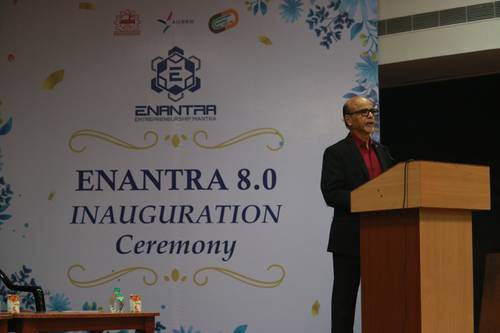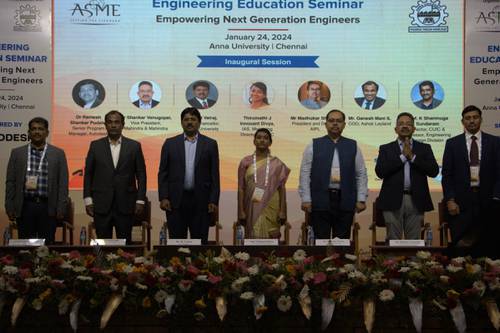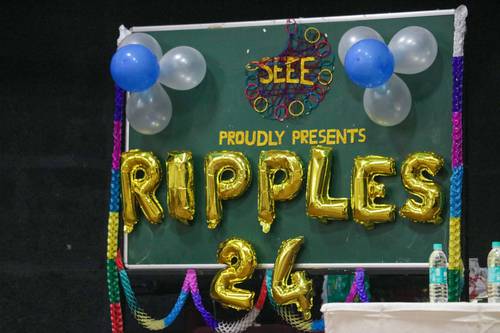At 9:30 am on a fine Monday morning, the KJ Auditorium of the SPIC Bioprocess Laboratory-Taramani Campus of Anna University was filled with voices of excited students and staff from the Center for Biotechnology (CBT). In the two hours that followed, an enlightening guest lecture left an indelible impression on the audience.
The speaker was a prominent biochemist known for his pioneering work in DNA replication, former President of the National Academy of Sciences (NAS), former Editor-in-Chief of Science (2009-2013) and has received the National Medal of Science in 2014 from U.S.President Barack Obama.
It was indeed a great honour to attend a lecture by Dr.Bruce Alberts, who is currently the Chancellor’s Leadership Chair in Biochemistry and Biophysics for Science and Education at the University of California, San Francisco.
Held on the 10th of August, the event was arranged by the Taylor & Francis Group of Garland Science, the original Publishers of Molecular Biology of the Cell, a textbook written by Dr. Alberts and his colleagues in 1983. Till date, the book is hugely popular and is read by students pursuing Life Sciences all around the world.
After being welcomed by the Director of CBT Prof. Gautam, Dr.Alberts took over the stage to deliver his speech.
Titled ‘A Life In Biology: Learning from textbook writing’, he began his presentation by evoking a thought provoking question that the great scientist Schrodinger had asked about DNA many years ago, “How can something so small be so stable?”
We learnt that this question was eventually answered after years of research; DNA being double stranded has 2 copies of the genetic information, which gives it stability.
The first part of the lecture was the story behind how he and his colleagues published Molecular Biology of the Cell.
He vividly described how Dr. James Watson (world renowned molecular biologist known for elucidating the structure of DNA) had requested him and a group of other scientists to help write a book on the molecular biology of the cell. Showing us pictures of their meetings, he described the long and arduous process of writing the various sections of the book. The authors had to edit each other’s work, which took a lot of their time and patience, and he termed this phase ‘The Fort-Hill Depression’. When they finally decided to bring editor Miranda Richardson on board their project, things began to look more promising.
We were shown how the various rounds of editing had been done on paper and the diagrams that had been sketched by artist and plant cell biologist, Keith Roberts.
After 365 more days of 12 hour ‘book meetings’, the first edition was finally published in 1983 by Bruce Alberts, Dennis Bray, Julian Lewis, Martin Raff, Keith Roberts and James D.Watson.
In December 2014, the 6th edition of this book was launched. Dr.Alberts told us more about the progressive changes through the various editions and the new authors who had contributed to them, while mentioning, “Each time we write an edition, we are humbled by how much we still don’t know”.
Hence, the latest edition has been introduced with questions highlighting ‘What We Don’t Know’ making students ponder about future areas of research.
The book is also linked to video animations and problems online (garlandscience.com), and we all gaped in awe at a short video of DNA replication shown to us.
“When I started graduate school in 1961, we all assumed the cell to be a ‘tiny test tube’. But this has been proved wrong with the discovery of the extensive set of scaffolds or sub-compartments present within the cell. Today we all know that these scaffolds are involved in forming many different biochemical factories inside the cell.”
He then spoke about the importance of mathematics in understanding biological pathways, and how computational models and simulations were being made for research studies.
The final section of his presentation was about his connection with India. Just a few days prior to this lecture, he was honoured with the Dr. M. S. Swaminathan Award for Environment Protection 2015 instituted by the Rotary Club of Madras East.
Being an active philanthropist, Prof. Alberts and his wife inaugurated a ‘Village Knowledge Center’ (VKC) at a village in Pondicherry nearly 10 years ago. An empowerment programme conceived by the MSSRF (M S Swaminathan Research Foundation) to facilitate technology and resources for the villagers, they visit it even today.
His final issue as Editor-In-Chief of Science also featured his trip to India and he explained how we all must develop a ‘scientific temper’ a term originally coined by Jawaharlal Nehru.
He is determined to reinvent science education for the better. With students of today merely memorising facts while learning science, he urges us to initiate the change by understanding science first, and keep questioning ourselves in order to learn more.
“Remember, a good scientist is one who is always sceptical”, he said.
He patiently answered a few questions from the audience, and concluded his talk.
Needless to say, it was a lecture we would never forget.





